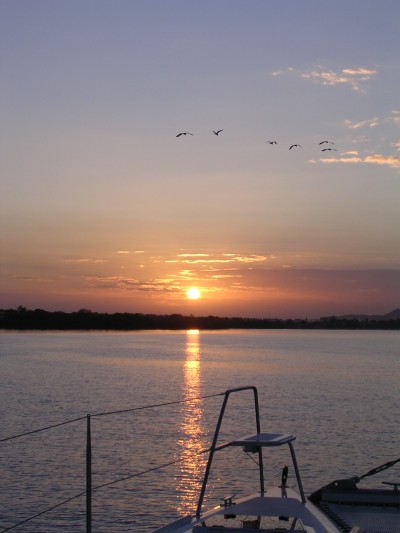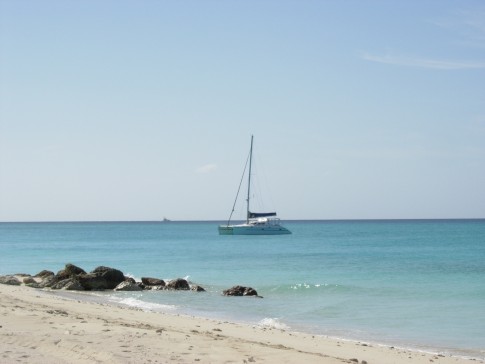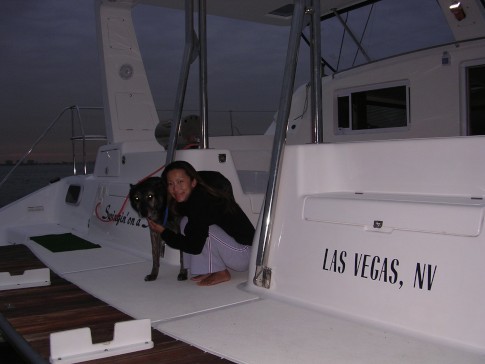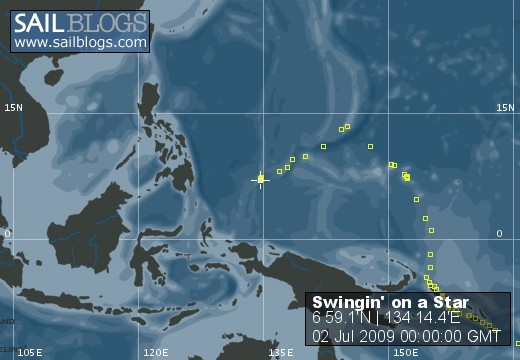
Swingin' on a Star
Ship's log for the circumnavigating Saint Francis 50 catamaran, "Swingin on a Star".
01 April 2010 | Palau
13 July 2009 | Palau
05 July 2009 | Yacht Harbor
03 July 2009 | Peleliu
02 July 2009 | Palau
01 July 2009 | Two Dog Beach
30 June 2009 | Mecharchar
29 June 2009 | Mecharchar
28 June 2009 | Ulong
27 June 2009 | Ngeruktabel
17 June 2009 | Ngeruktabel
16 June 2009 | Ngeruktabel
15 June 2009 | Ngeruktabel
14 June 2009 | Ngeruktabel
13 June 2009 | Ngerutable
25 May 2009 | Yacht Harbor
30 April 2009 | Malakal
29 April 2009 | Koror
28 April 2009 | Malakal
27 April 2009 | Malakal
The Mona Passage
05 March 2007 | Puerto Rico
Randy

The Mona Passage is not one of your straight forward crossings. There are several gremlins to consider when putting a passage plan together. Islands in the trade winds stream, especially good sized ones with fairly high mountains like Puerto Rico, can spawn their own frontal conditions. As the trades blow over Puerto Rico late in the day the cooling affect of the island can create squalls and thunder storms that roll off into the Mona Passage. You also have wind driven waves during the day that build up in a nasty fashion along the pointy eastern coast of the DR. The hour glass bank produces very choppy seas over its shoals. Trying to take all of this into account while planning your trip to maximize the night lees on both coasts with a daylight arrival can be tricky.
I swear that I am not on the take for Van Sant, but you really should read his book if you are sailing this area. He does a great job of helping you understand the issues and provides many useful tactics for dealing with the issues. Our plan was our own but we tried to avoid as many of the well known hazards as possible. We needed to take advantage of the night lee on the DR side to get around Cabo Cabron and onto the East coast of the DR. We also needed to get off of the East coast of the DR before the trades kicked in and made the coastline untenable. We wanted to take advantage of the night lee on the Puerto Rico side. The tricky part was trying to fit our boat speed into a night departure from the DR and a dawn arrival in PR. I budgeted 7 knots which made the fit difficult. In the end we settled on a 5AM departure from Escondido with a target arrival of just after 6AM in Boqueron Puerto Rico.
We woke up around 4AM and started to get the boat in shape. We were anchor up before 5AM and motoring out of the anchorage. It was sad to sail away from our new friends, slumbering in their vessels amid the cliffs. The exit was easy however as there is plenty of water and room on the way out and the huge cliffs are easy to follow even in the dark of night.
The wind was up around 20 knots around the cape. Cabo Cabron is a huge feature on the DR coastline and it fades into several other promontories that make up the headland around the north side of the DR's Bay of Samana. We followed the coastline south until around 8AM and then headed off shore to avoid the acceleration affect the coastline has on the trades and seas during the day.
We had motored to stay on schedule, to get around the cape and ensure that the first part of our passage was teed up properly. Once off shore we raised the main with a reef and laid in a course of 120 true to move gradually into the channel. We were making about 7 knots in 15 knots of wind fairly close hauled. We had to battle to keep our speed down so that we didn't arrive at the reefed entrance to Boqueron in the dark.
The day passed quietly as log entry after log entry went by. We saw a few other cruising boats traveling the opposite way across the channel and a few tankers plying the coast but nothing close enough to wave at.
The sun set as it usually does but it struck me that we had never watched it do so while under way. We had logged a few hours of night sailing at this point but we had never sailing into the night. This would be our first trip over 24 hours long. It was a brilliant sunset scattered into rainbow by our wake.
Hideko had been napping a fair bit of the day as I (really the autopilot) tended the helm. So as the darkness fell about us I started to get a bit tired. I was considering a nap when the wind started to pick up again. As it climbed into the 20 knot range we began to get a bit too far over our target average speed. Swingin' on a Star wanted to do 8 - 9 knots in the conditions so we had to roll up almost all of the jib to get her back into the 7 knot range.
Once we were settled back in with good sail trim and speed I headed into the saloon to take a nap. I asked Hideko to wake me up in a couple of hours but she was determined to let me sleep until I naturally woke up.
Hideko woke me up at midnight and she looked concerned. Have you ever tried to wake up and function in a constructive fashion instantaneously. That's what I tried to do. Doesn't work. I walked around the bridge deck for a few minutes trying to figure out where I was and what was happening. As reality began to make its way into my sensory perimeter I realized that we were becalmed. Hmmm, not good. This typically happens right before you get wacked.
Hideko gave me and update and pointed out Isla Desecheo by moon light. It is an important land mark when you are doing a northern crossing. We were crossing to the north to avoid any thunder storms that might be rumbling off into the passage. It was at this point that Hideko pointed out Desecheo on the radar and then asked me what the huge black mass was just to the north and east of us. I informed her that it was my opinion that we were looking at a big hairy rain storm coming right at us.
We fired up both diesels and headed south southeast fast. The rain storm morphed and reshaped itself as the western edge dissipated and the eastern side was refueled by the Puerto Rican coast. It arced around us to the east and north and wrapped around us to the west yet steering away from it by radar we didn't see one drop of rain. As we continued toward Boqueron we eventually escaped the black clouds to the north, shut down the diesels and got back on course.
The west coast of Puerto Rico has several rocks and shoal areas but it is fairly well marked being an extension of the US. This was almost weird. We were so used to being in places that have no aids to navigation (and if you do see one you should assume it is untrustworthy) that when we came upon the first lit channel buoy I was almost startled. It was actually on the chart and in the right place.
We neared Boqueron as the sun began to rise. This was good because we could now see around us, but bad because the sun was blinding us to the east. I had hoped to arrive just before sun up so that we could make the east bound harbor entrance in light but not blinding light. We laid back a bit until the sun got some altitude and then entered by the north entrance.
This is another Van Sant trick. There are two harbor entrances to Boqueron. The south entrance is the primary entrance and is clearly marked. That said it has reef on the north and south so with the sun rising in front of you it can be difficult to make out the buoys and there may be some current running you off track. The north entrance simply requires that you stay south of the shore line a safe distance. Using the north coast of the harbor as a guide we had no problem entering.
Boqueron is a big deep harbor and it takes a while to get all the way back to the anchorage proper. Hideko and I were both pretty tiered at this point but we took the time to anchor well and put the boat away reasonably. By 6AM we were on the hook and by 6:30 we were fast asleep with the Q flag flying once again.
I swear that I am not on the take for Van Sant, but you really should read his book if you are sailing this area. He does a great job of helping you understand the issues and provides many useful tactics for dealing with the issues. Our plan was our own but we tried to avoid as many of the well known hazards as possible. We needed to take advantage of the night lee on the DR side to get around Cabo Cabron and onto the East coast of the DR. We also needed to get off of the East coast of the DR before the trades kicked in and made the coastline untenable. We wanted to take advantage of the night lee on the Puerto Rico side. The tricky part was trying to fit our boat speed into a night departure from the DR and a dawn arrival in PR. I budgeted 7 knots which made the fit difficult. In the end we settled on a 5AM departure from Escondido with a target arrival of just after 6AM in Boqueron Puerto Rico.
We woke up around 4AM and started to get the boat in shape. We were anchor up before 5AM and motoring out of the anchorage. It was sad to sail away from our new friends, slumbering in their vessels amid the cliffs. The exit was easy however as there is plenty of water and room on the way out and the huge cliffs are easy to follow even in the dark of night.
The wind was up around 20 knots around the cape. Cabo Cabron is a huge feature on the DR coastline and it fades into several other promontories that make up the headland around the north side of the DR's Bay of Samana. We followed the coastline south until around 8AM and then headed off shore to avoid the acceleration affect the coastline has on the trades and seas during the day.
We had motored to stay on schedule, to get around the cape and ensure that the first part of our passage was teed up properly. Once off shore we raised the main with a reef and laid in a course of 120 true to move gradually into the channel. We were making about 7 knots in 15 knots of wind fairly close hauled. We had to battle to keep our speed down so that we didn't arrive at the reefed entrance to Boqueron in the dark.
The day passed quietly as log entry after log entry went by. We saw a few other cruising boats traveling the opposite way across the channel and a few tankers plying the coast but nothing close enough to wave at.
The sun set as it usually does but it struck me that we had never watched it do so while under way. We had logged a few hours of night sailing at this point but we had never sailing into the night. This would be our first trip over 24 hours long. It was a brilliant sunset scattered into rainbow by our wake.
Hideko had been napping a fair bit of the day as I (really the autopilot) tended the helm. So as the darkness fell about us I started to get a bit tired. I was considering a nap when the wind started to pick up again. As it climbed into the 20 knot range we began to get a bit too far over our target average speed. Swingin' on a Star wanted to do 8 - 9 knots in the conditions so we had to roll up almost all of the jib to get her back into the 7 knot range.
Once we were settled back in with good sail trim and speed I headed into the saloon to take a nap. I asked Hideko to wake me up in a couple of hours but she was determined to let me sleep until I naturally woke up.
Hideko woke me up at midnight and she looked concerned. Have you ever tried to wake up and function in a constructive fashion instantaneously. That's what I tried to do. Doesn't work. I walked around the bridge deck for a few minutes trying to figure out where I was and what was happening. As reality began to make its way into my sensory perimeter I realized that we were becalmed. Hmmm, not good. This typically happens right before you get wacked.
Hideko gave me and update and pointed out Isla Desecheo by moon light. It is an important land mark when you are doing a northern crossing. We were crossing to the north to avoid any thunder storms that might be rumbling off into the passage. It was at this point that Hideko pointed out Desecheo on the radar and then asked me what the huge black mass was just to the north and east of us. I informed her that it was my opinion that we were looking at a big hairy rain storm coming right at us.
We fired up both diesels and headed south southeast fast. The rain storm morphed and reshaped itself as the western edge dissipated and the eastern side was refueled by the Puerto Rican coast. It arced around us to the east and north and wrapped around us to the west yet steering away from it by radar we didn't see one drop of rain. As we continued toward Boqueron we eventually escaped the black clouds to the north, shut down the diesels and got back on course.
The west coast of Puerto Rico has several rocks and shoal areas but it is fairly well marked being an extension of the US. This was almost weird. We were so used to being in places that have no aids to navigation (and if you do see one you should assume it is untrustworthy) that when we came upon the first lit channel buoy I was almost startled. It was actually on the chart and in the right place.
We neared Boqueron as the sun began to rise. This was good because we could now see around us, but bad because the sun was blinding us to the east. I had hoped to arrive just before sun up so that we could make the east bound harbor entrance in light but not blinding light. We laid back a bit until the sun got some altitude and then entered by the north entrance.
This is another Van Sant trick. There are two harbor entrances to Boqueron. The south entrance is the primary entrance and is clearly marked. That said it has reef on the north and south so with the sun rising in front of you it can be difficult to make out the buoys and there may be some current running you off track. The north entrance simply requires that you stay south of the shore line a safe distance. Using the north coast of the harbor as a guide we had no problem entering.
Boqueron is a big deep harbor and it takes a while to get all the way back to the anchorage proper. Hideko and I were both pretty tiered at this point but we took the time to anchor well and put the boat away reasonably. By 6AM we were on the hook and by 6:30 we were fast asleep with the Q flag flying once again.
Comments
| Vessel Name: | Swingin' on a Star |
| Vessel Make/Model: | Saint Francis 50 |
| Hailing Port: | Las Vegas, NV |
| Crew: | Randy Abernethy |
| Home Page: | http://swinginonastar.com |
Swingin on a Star

Who: Randy Abernethy
Port: Las Vegas, NV






